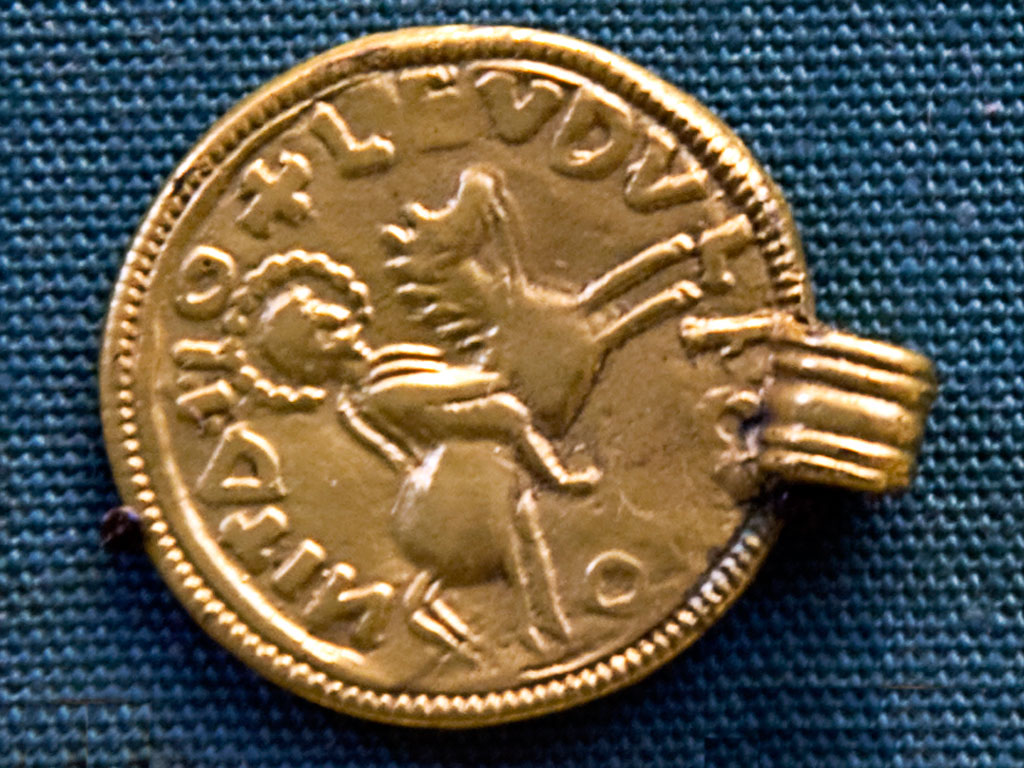The “Martin” of the 7th to 10th centuries was not the ascetic bishop of the 5th century. The leopard changed its spots and became a National Frankish saint and a budding Christian Knight
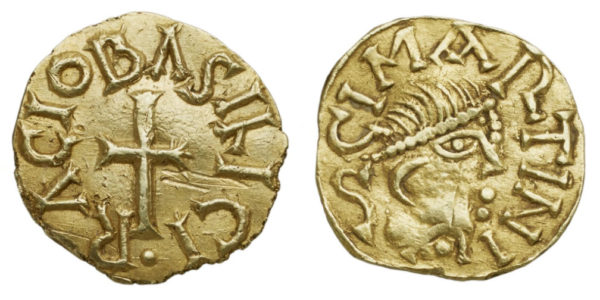
At the same time as Gregory positioned St. Martin as the spearhead for Tours as an important pilgrimage centre, he also made an effort to frame the holy man as the National Frankish Saint. Nowhere is this more evident than in Gregory’s retelling of the preparations, Clovis took before his war against the Visigoths in 507. According to Gregory, the Merovingian king passed through Tours on his way with his army towards Poitiers. At Tours, Clovis commanded his army to desist from pillaging the town and the countryside. “How might we gain a victory if the holy Martin is angered” are the words put into the royal mouth by the historian. Also, the king is reported to have sent messengers with gifts to all the churches dedicated to St Martin, thus supplicating him for signs of victory as well as divine assistance. After the victorious battle at Voully, Clovis is said to have donated part of the spoils to St Martin in Tours.
Of particular importance was the later veneration of the half mantel or cape of St Martin, said to have been kept as a relic at Tours. In the original vitae, we hear of a “tunica” or “chlamys”. Later Merovingian sources (c. 650 – 660), renamed the vestment a “capella”, while more than a hundred years later, in Carolingian times, the vestment was called a “capa”. Exactly when this relic was adopted as the treasured symbol of the Merovingian Kings’ divine approbation is not known. But the reverence attached to the relic can be dated at least to the mid 7thcentury. Thus the “Cappa” is mentioned in documents from 679 and 682 as part of the royal treasury. At this point, the piece of cloth had already been taken from Tours and brought to Paris, where it came to be kept safe in a special oratory, or “Cappella”. Soon after, however, the mantle may have fallen into the hands of Pippin of Herstal (635 – 714) father of Charles Martel (688 – 741) and Grimoald († 714), who is said to be its keeper in 709 (Capellanus). From here, the treasured piece of cloth came to gird the power base of the Carolingians. In connection with this should be noted the many churches dedicated to St Martin in the power base of the Carolingians: Utrecht, Cologne, Würzburg and elsewhere. Finally, it is significant that the Bavarian Duke Tassilo (741 – 796) had to swear allegiance to Pippin the Short (714 – 751) in 757 on St. Dionysius, Germanus and Martin. This event probably took place at St. Germain de Pres in Paris. Perhaps the mantel was kept there in its “Cappela”? Anyway, at this point, it was likely not the half mantel, but rather a cloth, which had been used to cover the tomb of the saint at his burial. As such, it was used as a standard carried in front of The Frankish Army and into battle.
Italy
In the same way, as Martin was enrolled as a Christian knight whenever heathens or Arians were fought, he was fitted with a similar disguise in Italy. Here, one of the first churches consecrated to St Martin was the Arian Basilica in Ravenna. Erected by the Ostrogoth King, Theoderic the Great as his palace church during the first part of the 6thcentury, the basilica was re-consecrated as Catholic in 561 under the name of St Martin in the Golden Heaven – Sanctus Martinus in Coeli Aureo. As the golden mosaics were perhaps covered up, the new name was a misnomer until Bishop Agnellus fifty years later had the two bands of virgins and martyrs made. The latter parade was led by St Martin, in a red cloak, perhaps signalling his “imperial” connection. Already at this point, he is a curious mixture of monk and soldier, if not a leader of men. The mosaic is the first visual rendition of St. Martin.

Anglo-Saxon England
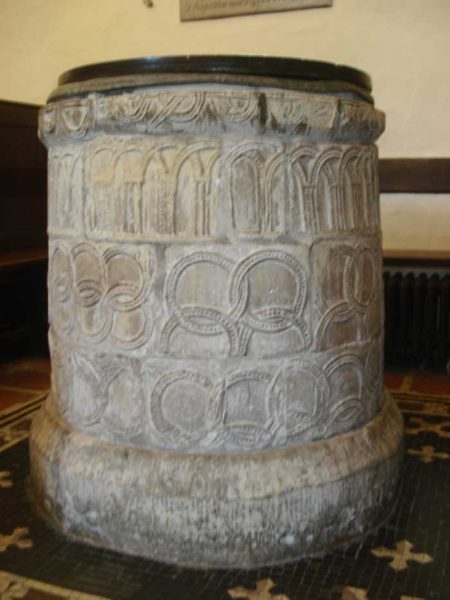
At this point, the cult of St Martin was also being exported to England as part of the missionary efforts of Gregory the Great. One of the significant frontiers was Anglo-Saxon England, and it is no wonder, the very first church either renovated or built from new after the arrival of Queen Bertha of Kent c. 580, was consecrated to Martin. Bertha was a Frankish princess, who seems to have brought her favourite royal saint to the English shores of her new pagan home. Bede later claimed that St Martin’s was a derelict church from the late Roman period. Whether or not this was the case is uncertain. We do know, though, that the church was built with Roman bricks and a full section of the wall is Roman. It is not known whether the building was originally a church, a mausoleum, or something entirely different. Later, when St Augustine arrived in 597, the church was turned into his headquarter and renovated. It still stands and is designated as part of our UNESCO World Heritage.
It has been speculated that the consecration of the church to S. Martin reflected not just aspirations of a homesick princess, but an early local tradition of the veneration of St Martin in Celtic Ireland and Britain. Bede mentions the erection of a church at Whithorn built in 397 to commemorate St Martin. Other early St Martin’s churches can be found in Cornwall, in Somerset, and even more intriguing, at Brampton, where it was built within the confines of a former Roman fort on the Wall of Hadrian. Other evidence is the eight wells dedicated to St Martin. A later gazetteer from 1914 counts 173 dedications to St Martin, although most of some of these are arguably much later.
Especially noteworthy are the vernacular translations of his life, which date to the 10thcentury. In these, the figure of St Martin was fashioned not only as an exemplary missionary, monk, and bishop, in which role he was aligned with the Benedictine revival but also as a man willing to take the fight to its absolute end. Thus he was inferred to have acted as inspiration for two Anglo-Saxon kings, Sigeberht and St Edmund, who both – according to Bede respectively Ælfric – chose to lay down their weapons, while confronting their enemies.
Norman England and Scandinavia
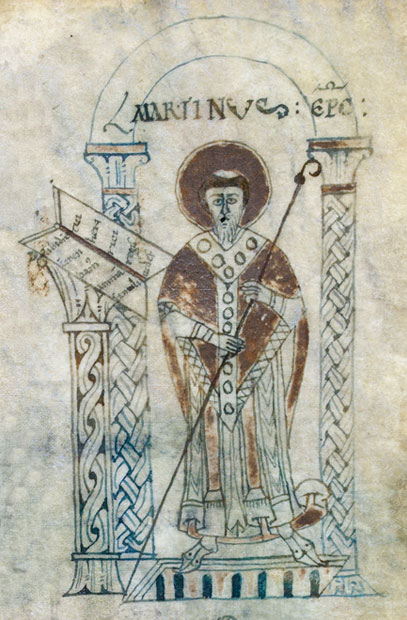
After the invasion in 1066, St Martin experienced a revival. Perhaps, to use him in their personal endeavours to “reimagine” the Duchy of Normandy as on par with a proper kingdom, the military saint became especially revered by the Normans. Did they perhaps play with the idea of confiscating the National French Saint? We know that while churches consecrated to St Martin were old and scarce in Anglo-Saxon England, they were liberally spread over Northern France and might be counted in the hundreds. Germane to this, the so-called Battle Abbey, founded by William after the conquest in 1066 was named “Sancto Martino de Bello” (St Martin of the War). Legend has it that the Abbey was either built as penance for William’s conquest, or as gratitude for his victory. According to the Chronicon de Bello, William swore on the battle-ground to found an Abbey, where monks might “dwell together for the salvation of all, but especially those who should fall in the battle”. It is further told that a monk, who was a former member of the ducal retinue but now professed at Marmoutier, claimed the new abbey for the French national saint. Another church named after the saint and under the purview of the new king was St Martin’s Le Grand in London, which William favoured with donations in 1068. The church may have dated to the 7thcentury. In 1056 it was, however, rebuilt. This particular church was responsible for sounding the curfew bell signalling the closing of the gates of the city.
The affinity between the Normans and St Martin may have reached further. When Emma of Normandy died in 1052, she was not buried next to her husband, Cnut, but rather in St Martin’s in Winchester. Further, according to a legend told by the Danish historian Sven Aggesen in his Brevis Historia Regum Dacie from c. 1186, King Cnut the Great c. 1020 claimed the relics of the Saint at Tours and forcefully transported them to Rouen. Generally believed to be a myth, it is nevertheless remarkable that the Cathedral in Lund, the first of which was built during his reign, was later said to possess relics of St Martin. It is likely this story was swirling around the court of Valdemar I, where Sven seems to have been part of the “Thinglied” (the royal retinue). As a descendant of one of Cnut’s men, he may also have heard the story in his childhood.
There might be a small kernel of truth in the story. In Scandinavia, St Martin was apparently one of the saints introduced as part of the first missionary effort in the 11thcentury. Apart from the documented relics, the saint was listed in the earliest calendar from Lund. Another indication is a small early wooden church believed to have been built beneath the stone church of St Marten (or Maarten) from c. 1100. This places the wooden church (documented through burials) in the first half of the 11thcentury at a time when Lund was the metropolis of Cnut the Great and his descendants. From the same period, a Swedish fragment of a missal is preserved witnessing to a vibrant cult of St Martin further east.
Germany
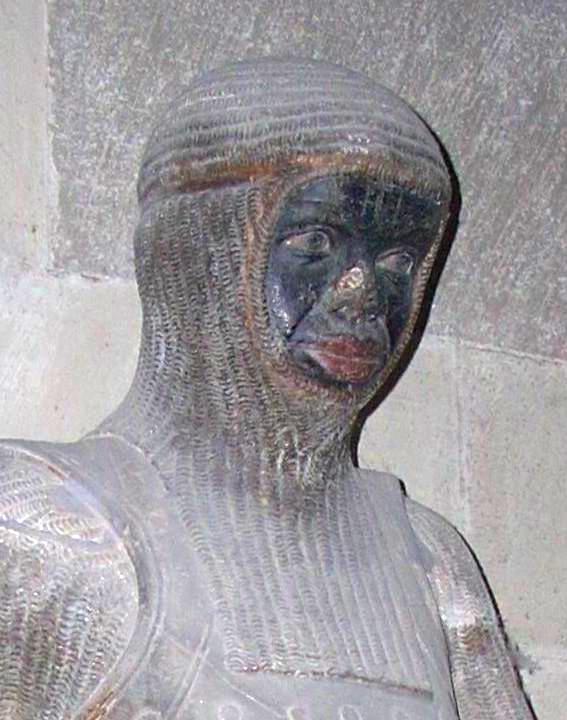
After the civil war in the 9thcentury between the grandsons of Charlemagne, Martin had to compete on quite another level with yet a contender to the saintly royal pantheon, St Maurice d’Agaune († 290). He was the leader of a legendary Theban legion stationed in the foothills of the Alps at Agaune in. The legionaries were Christians, who defied the Roman Emperor by taking a stand against his orders to persecute their fellow men. St Maurice was early on adopted as the national saint by the Burgundians, whose kingdom the Franks conquered in 532 at the Battle of Vézeronce. Despite this, the Burgundian kingdom continued to resurface during the next centuries. These events secured the continued significance of the Abbey at Augune and its two royal saints St Maurice and Sigismund († 524). After the division in 843 of the Frankish kingdom into three parts, the strip between the realm of Charles the Bald and Louis the German fell to Lothar and his son. This led to a continued series of wars between the two remaining grandsons and their heirs until Rudolf I succeeded in being crowned as king of Burgundy in 888 at St Maurice d’Agaune. During the 10thcentury, the Saxon rulers of Germany succeeded in incorporating the Burgundian kingdom into their sphere of interest. Doubtless, this was confirmed through the adoption of the St. Maurice as the national saint of Germany. Especially, Otto the Great (912 – 973) showed a disproportionate interest in marketing this saint as “German”. In 937, Otto founded a Benedictine Abbey in Magdeburg, dedicated to St. Mauritius, who received substantial relics from Augune in 960. His first wife, Edgitha, was buried there, not far from the later Cathedral of which construction began in 955. At least since 965, Mauritius was appointed the personal patron of the emperor and his family. Afterwards, Mauritius was the official German saint entrusted with keeping the Holy Roman Empire safe. The explanation is not complicated to identify. Since the Early Middle Ages, St Mauritius was the guardian of the pass at Great Saint Bernhard. Thus he was also the guardian of the western passage through the Alps to Italy and the key to holding the imperial crown.
Although it was only later the Holy Lance was (falsely) identified as having been in the keep of St Mauritius in his lifetime, it is significant that this imperial insignia was to be joined so manifestly together with the national saint of the German Empire. While the French and Anglo-Saxon kept St Martin close by, the Germans adopted a competitive saint, St Mauritius as the Miles Christi, par excellence.
FEATURED PHOTO:
Pendant from the Canterbury Hoard © British Museum
READ THE FULL STORY
Martin of Tours – a Man of all Times
Martin of Tour in the 4thcentury – Roman Soldier, Ascetic Athlete, and Reluctant Bishop
Martin of Tours in the 6thcentury – from Ascetic Saint to Local Miracle Worker
The European Fame of St Martin of Tours – from National Frankish Hero to Christian Knight
St. Martin in Moissac – the Oldest Church in France
SOURCES:
The History of the Franks
By Gregory of Tours
Penguin 1974.
Soldiers of Christ: Saints and Saint’s Lives from Late Antiquity and the early Middle Ages
By Thomas F. X. Noble and Thomas Head
Penn State Press 2010
Helden und Heilige. Kulturelle und literarische Integrationsfiguren des europäischen Mittelalters.
Ed. by Andreas Hammer, Stephanie Seidl, Jan-Dirk Müller and Peter Strohschneider
Heidelberg, Winter Verlag 2011
